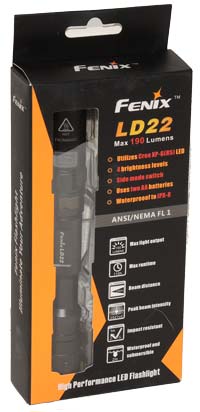
Several years ago, Julie reviewed the Fenix LD20 LED flashlight (see related links) which, for the most part, received a positive review. The only negative comment she gave involved how Fenix engineered its brightness/mode switching feature. With the LD20, you had to twist the cap to switch between modes. Well, it looks like their designers listened to Julie and fixed the one issue she had with the LD20. The LD22 is Fenix’s follow-up to the LD20 with a bit more polish, horsepower (aka brightness), and a few added features as well. The folks at Fenix Outfitters sent one for me to tryout and review. Like its predecessor, the LD22 is made of T6 aircraft-grade aluminum with a durable Type III hard anodized finish. The Cree XP-G (R5) LED has a lifespan of 50,000 hours and is protected by a hardened ‘ultra-clear’ glass lens with an anti-reflective coating. One of the great features of the LD-series of flashlights is that they are powered by standard-sized AA batteries. These are much easier to get on the fly than CR123As that many flashlights are powered by.
Like its predecessor, the LD22 is made of T6 aircraft-grade aluminum with a durable Type III hard anodized finish. The Cree XP-G (R5) LED has a lifespan of 50,000 hours and is protected by a hardened ‘ultra-clear’ glass lens with an anti-reflective coating. One of the great features of the LD-series of flashlights is that they are powered by standard-sized AA batteries. These are much easier to get on the fly than CR123As that many flashlights are powered by.
Features:
- Cree XP-G (R5) LED with a lifespan of 50,000 hours
- Uses two 1.5V AA (Ni-MH, Alkaline ) batteries
- 6.1″ (156mm) long x 0.85″ (21.5mm) diameter
- 2.1 ounces (60g) weight (excluding batteries and body clip)
- Digitally regulated output maintains constant brightness
- Reverse polarity protection guards against improper battery installation
- Anti-roll, slip-resistant body design
- Push-button tail cap switch with momentary-on function
- Side mode switch in the front, fast and convenient
- Made of durable aircraft-grade aluminum
- Premium Type III hard-anodized anti-abrasive finish
- Toughened ultra-clear glass lens with anti-reflective coating
Package Contents:
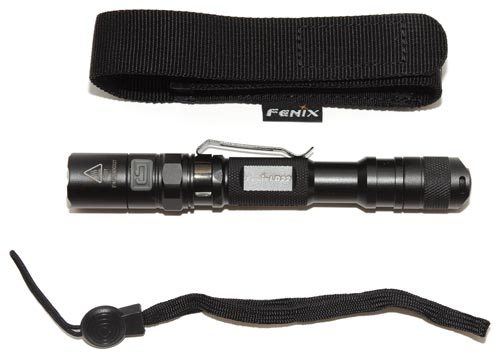
- LD22 flashlight
- Nylon Holster
- Lanyard
- Two spare o-rings
Specifications and Runtimes:
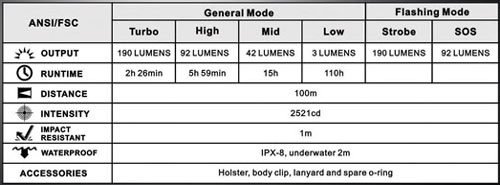
The mode button can switch the flashlight through four brightness levels and from steady-state to either strobe or SOS modes. Depending on your illumination needs, the LD22 can run between 2.5 and 110 hours. While you can still see some difference, I found little difference in brightness between the High and Turbo settings. Turbo was definitely brighter, but not doubly so. In either Turbo or High mode, the LD22 is very bright, and the strobe feature is certainly noticeable/eye-catching. For its size, this relatively small (AA powered) flashlight produces an impressive and highly uniform field of light.
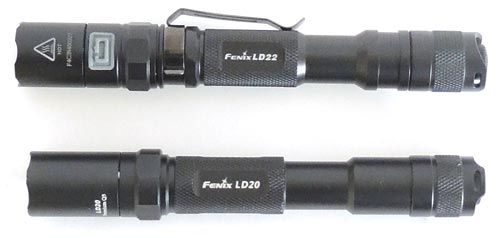 As I said and you can see, other than the mode switch on the side of the LD22, there is little difference between these flashlights. There are also two insets on either side of the barrel of the LD22 to accomodate the pocketclip, which is a new feature as well. Digitally-regulated output maintains constant brightness as the batteries are depleted.
As I said and you can see, other than the mode switch on the side of the LD22, there is little difference between these flashlights. There are also two insets on either side of the barrel of the LD22 to accomodate the pocketclip, which is a new feature as well. Digitally-regulated output maintains constant brightness as the batteries are depleted.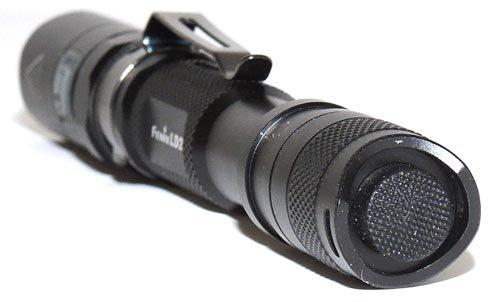 The push-button tail cap switch allows for convenient, momentary-on function of the flashlight. The tailcap is designed to unscrew to allow access to the batteries. An O-ring keeps the inside chamber watertight to two meters. The knurled design on the barrel of the body gives the flashlight a pleasing feel and solid grip. Along with a good feel, its relatively light weight and thin body make it ideal for travel gear.
The push-button tail cap switch allows for convenient, momentary-on function of the flashlight. The tailcap is designed to unscrew to allow access to the batteries. An O-ring keeps the inside chamber watertight to two meters. The knurled design on the barrel of the body gives the flashlight a pleasing feel and solid grip. Along with a good feel, its relatively light weight and thin body make it ideal for travel gear.
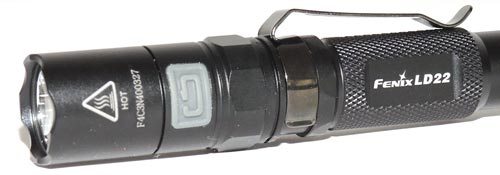 The max output setting of 190 lumens can cause the torch-end of the flashlight to get warm/hot during extended periods of use. Since I received the L22 for review, Fenix has upgraded the LED on the LD22 to 215 lumens. The higher-lumen version is now available.
The max output setting of 190 lumens can cause the torch-end of the flashlight to get warm/hot during extended periods of use. Since I received the L22 for review, Fenix has upgraded the LED on the LD22 to 215 lumens. The higher-lumen version is now available.
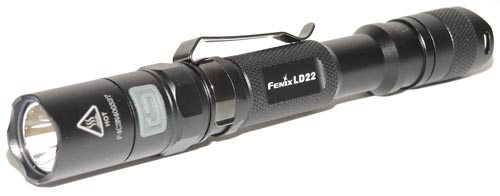 I have been using the Fenix LD20 for years, and it continues to not only work well but look as if it were new. The LD22 is just as well made, has better features/design, and is brighter for approximately the same cost as its predecessor. At under $70, the LD22 is a great bang for the buck and makes a great travel companion, glovebox gear, birthday gift, or stocking stuffer.
I have been using the Fenix LD20 for years, and it continues to not only work well but look as if it were new. The LD22 is just as well made, has better features/design, and is brighter for approximately the same cost as its predecessor. At under $70, the LD22 is a great bang for the buck and makes a great travel companion, glovebox gear, birthday gift, or stocking stuffer.
ESR for MagSafe Wallet with Stand, RFID Blocking with MagSafe Ring, 5 Card Holder for Phone Case, Slim Leather Magnetic Wallet for iPhone 17/16/15/14/13/12 Series(Not for Mini), Selected Samsung,Black
33% OffApple iPhone FineWoven Wallet with MagSafe – Black
15% OffProduct Information
| Price: | Available for under $60 |
| Manufacturer: | Fenix |
| Retailer: | Fenix Outfitters |
| Pros: |
|
| Cons: |
|



Gadgeteer Comment Policy - Please read before commenting
I recently picked up one of the LED Lenser F1, which is 400 lumens (or throttles if you like) and runs 120 min at that rate. The F1 is smaller and just an insane little super high power light.
I got the Fenix LD22 light, and found this thing to be versatile. On low, it is nice to navigate in darkness. It is about as bright as those old flashlights used to be, yet the batteries last much longer. The higher settings are excellent to do more detailed work–perfect for repairing things where your old flashlight is too wimpy.
It is also good to carry at all times for emergencies. You never know when you will be at the mall or big-box store and the lights go out. If the generator goes dead, this light can make the difference between not being able to purchase what you went in for, and a major safety and security hazard. Or, if you are doing any kind of door to door work (many repair people do this when they have to deliver things up stairs), this light will come in handy if the lights go out or the light bulb blows, and there is no emergency light. From roadside emergencies at night, to blackouts at the mall, to repair work at home, to searching a drawer, this is the perfect light.
One note: You are best with NiMH rechargeable batteries. Use alkalines, and you might not be able to access the low setting (which is used to pitch that tent or see without disturbing others). Also, alkaline batteries have a bad habit of leaking, which can ruin the finest lights. This is especially true if you use the light for household emergencies and the emergency takes a few years to happen. Low self-discharge NiMH batteries are perfect for this. Bonus: You place fewer batteries in the rubbish, you buy fewer batteries, and you spend less on batteries.
And don’t let the cost throw you. This light is comparably priced to much bulkier lights from the 1960s, when inflation is factored in. You get to use common AA batteries, and with NiMH batteries you might spend less total on light and batteries with this fine light than with even the cheapest flashlight during the life of the light. And, let’s not forget that you do not wish to change a blown flashlight bulb just when you need it most. This will not blow.
How does this compare to similar offerings from LED Lenser, COAST etc?